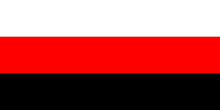Mordvins
The Mordvins, also Mordva, Mordvinians, Mordovians (Erzya: эрзят/erzät, Moksha: мокшет/mokšet, Russian: мордва/mordva), are a people who speak the Mordvinic languages of the Uralic language family and live mainly in the Republic of Mordovia and other parts of the middle Volga River region of Russia.[3]
 Moksha girls in traditional costumes in Zubovo-Polyansky District, Mordovia. | |
| Total population | |
|---|---|
| 843,350 (2002) | |
| Regions with significant populations | |
| 744,237 (2010)[1] |
| Languages | |
| Erzya, Moksha, Russian | |
| Religion | |
| Predominantly † Eastern Orthodox Christianity (Russian Orthodox Church) minority Mordvin Native Religion, Lutheranism, Molokans and Jumpers[2] | |
| Related ethnic groups | |
| Mari; other Volga Finns | |
The Mordvins comprise one of the more numerous indigenous peoples of Russia. They identify themselves as separate ethnic groups:[3]
- Erzya
- Moksha
- Teryukhan
- Tengushev (or Shoksha) Mordvins who became fully Russified or Turkified during the 19th to 20th centuries
Less than one third of Mordvins live in the autonomous republic of Mordovia; the rest are scattered over the Russian oblasts of Samara, Penza, Orenburg and Nizhny Novgorod, while others live in Tatarstan, Chuvashia, Bashkortostan, Central Asia, Siberia, the Russian Far East, Kazakhstan, Azerbaijan, Armenia and the United States.
The Erzya Mordvins (Erzya: эрзят, Erzyat; also Erzia, Erza), who speak Erzya, and the Moksha Mordvins (Moksha: мокшет, Mokshet), who speak Moksha, are the two major groups. The Qaratay Mordvins live in the Kama Tamağı District of Tatarstan and speak a Tatar language - albeit with a large proportion of Mordvin vocabulary (substratum). The Teryukhan, living in the Nizhny Novgorod Oblast of Russia, switched to using Russian in the 19th century. The Teryukhans recognize the term Mordva as pertaining to themselves, whereas the Qaratay also call themselves Muksha. The Tengushev Mordvins live in southern Mordovia and form a transitional group between Moksha and Erzya.
The western Erzyans are also called Shoksha (or Shoksho). They are isolated from the bulk of the Erzyans, and the Mokshan dialects have influenced their dialect/language.
Names
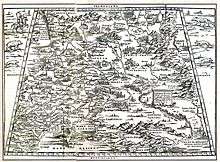
While Robert G. Latham had identified Mordva as a self-designation, identifying it as a variant of the name Mari,[4] Aleksey Shakhmatov in the early 20th century noted that Mordva was not used as a self-designation by the two Mordvinic tribes of the Erzya and Moksha. Nikolai Mokshin again states that the term has been used by the people as an internal self-defining term to constitute their common origin.[5] The linguist Gábor Zaicz underlines that the Mordvins do not use the name 'Mordvins' as a self-designation.[6] Feoktistov wrote "So-called Tengushev Mordvins are Erzyans who speak [the] Erzyan dialect with Mokshan substratum and in fact they are [an ethnic] group of Erzyans usually referred to as Shokshas. [It] was [the] Erzyans who historically [were] referred to as Mordvins, and Mokshas usually were mentioned separately as "Mokshas". There is no evidence Mokshas and Erzyas were an ethnic unity in prehistory".[7] Isabelle T. Keindler writes:
Gradually major differences developed in customs, language and even physical appearance (until their conversion to Christianity the Erzia and Moksha did not intermarry and even today intermarriage is rare.) The two subdivisions of Mordvinians share no folk heroes in common – their old folksongs sing only of local heroes. Neither language has a common term to designate either themselves or their language. When a speaker wishes to refer to Mordvinians as a whole, he must use the term "Erzia and Moksha"[8]
Early references
The ethnonym Mordva is possibly attested in Jordanes' Getica in the form of Mordens who, he claims, were among the subjects of the Gothic king Ermanaric.[9] A land called Mordia at a distance of ten days journey from the Petchenegs is mentioned in Constantine VII's De administrando imperio.[10] In medieval European sources, the names Merdas, Merdinis, Merdium, Mordani, Mordua, Morduinos have appeared. In the Russian Primary Chronicle, the ethnonyms Mordva and mordvichi first appear in the 11th century. After the Mongol invasion of Rus', the name Mordvin rarely gets mentioned in Russian annals, and is only quoted after the Primary Chronicle up until the 15th–17th centuries.[11][12]
Etymologies
The name Mordva is thought to originate from an Iranian (Scythian) word, mard, meaning "man". The Mordvin word mirde denoting a husband or spouse is traced to the same origin. This word is also probably related to the final syllable of "Udmurt", and also in Komi: mort and perhaps even in Mari: marij.[13]
The first written mention of Erzya is considered to be in a letter dated to 968 AD, by Joseph, the Khazar khagan, in the form of arisa, and sometimes thought to appear in the works of Strabo and Ptolemy as Aorsy and Arsiity, respectively. Estakhri, from the 10th century, has recorded among the three groups of the Rus people the al-arsanija, whose king lived in the town of Arsa. The people have sometimes been identified by scholars as Erzya, sometimes as the aru people, and also as Udmurts. It has been suggested by historians that the town Arsa may refer to either the modern Ryazan or Arsk[10] In the 14th century, the name Erzya is considered to have been mentioned in the form of ardzhani by Rashid-al-Din Hamadani,[14] and as rzjan by Jusuf, the Nogaj khan[15] In Russian sources, the ethnonym Erza first appears in the 18th century.[16]
The earliest written mention of Moksha, in the form of Moxel, is considered to be in the works of a 13th-century Flemish traveler, William of Rubruck, and in the Persian chronicle of Rashid-al-Din, who reported the Golden Horde to be at war with the Moksha and the Ardzhans (Erzia). In Russian sources, 'Moksha' appears from the 17th century.[17]
Ethnic structure
The Mordvins are divided into two ethnic subgroups[18][19] and three further subgroups:[4][20]
- the Erzya people or Erzyans, (Erzya: Эрзят/Erzyat), speakers of the Erzya language. Less than half of the Erzyans live in the autonomous republic of Mordovia, Russian Federation, Sura River and Volga River. The rest are scattered over the Russian oblasts of Samara, Penza, Orenburg, as well as Tatarstan, Chuvashia, Bashkortostan, Siberia, Far East, Armenia and USA.
- the Moksha people or Mokshans, (Moksha: Мокшет/Mokshet), speakers of the Moksha language. Less than half of the Moksha population live in the autonomous republic of Mordovia, Russian Federation, in the basin of the Volga River. The rest are scattered over the Russian oblasts of Samara, Penza, Orenburg, as well as Tatarstan, Siberia, Far East, Armenia, Estonia, Australia and USA.
- the Shoksha or Tengushev Mordvins constitute a transitional group between the Erzya and Moksha people and live in the southern part of Republic of Mordovia, in the Tengushevsk and Torbeevsk region.
- the Karatai Mordvins or Qaratays live in the Republic of Tatarstan. They no longer speak a Volga-Finnic language but have assimilated with Tatars.
- the Teryukhan Mordvins live near Nizhny Novgorod had been completely Russified by 1900 and today unambiguously identify as ethnic Russians.
Mokshin concludes that the above grouping does not represent subdivisions of equal ethnotaxonomic order, and discounts Shoksha, Karatai and Teryukhan as ethnonyms, identifying two Mordvin sub-ethnicities, the Erzya and the Moksha, and two "ethnographic groups", the Shoksha and the Karatai.[21]
Two further formerly Mordvinic groups have assimilated to (Slavic and Turkic) superstrate influence:
- The Meshcheryaks are believed to be Mordvins who have converted to Russian Orthodox Christianity and have adopted the Russian language.
- The Mishars are Mordvins who came under Tatar influence and adopted the language (Mishar Tatar dialect) and the Sunni Muslim religion.[22]
Religion
Erzya practices Christianity (Eastern Orthodox and Lutheranism brought by Finnish missionaries in the 1990s) and Ineshkipaza, a native monotheistic religion with some elements of pantheism. Almost all national-oriented intellectuals practice Ineshkipazia or Lutheranism.
Mariz’ Kemal, well-known Erzyan poetess, is also an organizer of traditional Erzyan religion communities. This phenomenon appeared after formation of Mordovian diocese of ROC in 1990. In those days Erzyan intellectuals were hoping to introduce of Erzyan language into worship ceremonies as well as to revive of Erzyan religious and cultural identity, even within ROC structure. Failure of these hopes made many Erzyan believers more radical and stimulated national-oriented intellectuals to renew their ethnic Ineshkipaza religion.
Appearance

The 1911 Britannica[23] noted that the Mordvins, although they had largely abandoned their language, had "maintained a good deal of their old national dress, especially the women, whose profusely embroidered skirts, original hair-dress large ear-rings which sometimes are merely hare-tails, and numerous necklaces covering all the chest and consisting of all possible ornaments, easily distinguish them from Russian women."
Britannica described the Mordvins as having mostly dark hair and blue eyes, with a rather small and narrow build. The Moksha were described as having a darker skin and darker eyes than the Erzya, while the Qaratays were described as "mixed with Tatars".
Latham described the Mordvins as taller than the Mari, with thin beards, flat faces and brown or red hair, red hair being more frequent among the Ersad than the Mokshad.[4]
James Bryce described "the peculiar Finnish physiognomy" of the Mordvin diaspora in Armenia, "transplanted hither from the Middle Volga at their own wish", as characterised by "broad and smooth faces, long eyes, a rather flattish nose".[24]
Cultures, folklores and mythologies
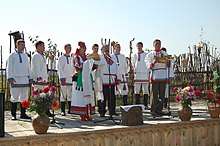
According to Tatiana Deviatkina, although sharing some similarities, no common Mordvin mythology has emerged, and therefore the Erza and Moksha mythologies are defined separately.[25]
In the Erza mythology, the superior deities were hatched from an egg. The mother of gods is called Ange Patiai, followed by the Sun God, Chipaz, who gave birth to Nishkepaz; to the earth god, Mastoron kirdi; and to the wind god, Varmanpaz. From the union of Chipaz and the Harvest Mother, Norovava, was born the god of the underworld, Mastorpaz. The thunder god, Pur’ginepaz, was born from Niskende Teitert, (the daughter of the mother of gods, Ange Patiai). The creation of the Earth is followed by the creation of the Sun, the Moon, humankind, and the Erza. Humans were created by Chipaz, the sun god, who, in one version, molded humankind from clay, while in another version, from soil.
In Moksha mythology, the Supreme God is called Viarde Skai. According to the legends, the creation of the world went through several stages: first the Devil moistened the building material in his mouth and spat it out. The piece that was spat out grew into a plain, which was modeled unevenly, creating the chasms and the mountains. The first humans created by Viarde Skai could live for 700–800 years and were giants of 99 archinnes. The underworld in Mokshan mythology was ruled by Mastoratia.
Latham reported strong pagan elements surviving Christianization.[4] The 1911 Britannica noted how the Mordvins:
… still preserve much of their own mythology, which they have adapted to the Christian religion. According to some authorities, they have preserved also, especially the less russified Moksha, the practice of kidnapping brides, with the usual battles between the party of the bridegroom and that of the family of the bride. The worship of trees, water (especially of the water-divinity which favours marriage), the sun or Shkay, who is the chief divinity, the moon, the thunder and the frost, and of the home-divinity Kardaz-scrko still exists among them; and a small stone altar or flat stone covering a small pit to receive the blood of slaughtered animals can be found in many houses. Their burial customs seem founded on ancestor-worship. On the fortieth day after the death of a kinsman the dead [one] is not only supposed to return home, but a member of his household represents him, and, coming from the grave, speaks in his name... They are also masters of apiculture, and the commonwealth of bees often appears in their poetry and religious beliefs. They have a considerable literature of popular songs and legends, some of them recounting the doings of a king Tushtyan who lived in the time of Ivan the Terrible.[23]
History
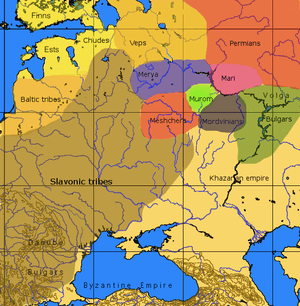
Prehistory
The Mordvins emerged from the common Volgaic group around the 1st century AD.[26]
Proof that the Mordvins have long been settled in the vicinity of the Volga is also found in the fact that they still call the river Rav, reflecting the name Rha recorded by Ptolemy[27][28] (c. AD 100 – c. 170).
The Gorodets culture dating back to around 500 BC has been associated with these people. The north-western neighbours were the Muromians and Merians who spoke related Finno-Ugric languages. To the north of the Mordvins lived the Maris, to the south the Khazars. The Mordvins' eastern neighbors, possibly remnants of the Huns, became the Bolgars around 700 AD.
Researchers have distinguished the ancestors of the Erzya and the Moksha from the mid-1st century AD by the different orientations of their burials and by elements of their costumes and the variety of bronze jewellery found by archaeologists in their ancient cemeteries. The Erzya graves from this era were oriented north-south, while the Moksha graves were found to be oriented south-north.[10]
The Mordvin language began to diverge into Moksha and Erzya over the course of the 1st millennium AD.[29][30] Erzyans lived in the northern parts of the territory, close to present-day Nizhny Novgorod. The Mokshans lived further south and west of present-day Mordovia, closer to the neighbouring Iranian, Bolgar and Turkic tribes, and fell under their cultural influence.
The social organization of Moksha and Erzya depended on patriarchy; the tribes were headed by elders kuda-ti who selected a tekshtai, senior elders responsible for coordinating wider regions.
Early history
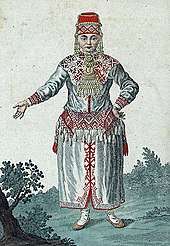
Around 800 AD two major empires emerged in the neighborhood: Kievan Rus in present-day Ukraine and Russia adopted Eastern Orthodox Christianity, the Bolgar kingdom located at the confluence of Kama and Volga rivers adopted Islam, and some Moksha areas became tributaries to the latter until the 12th century.
Following the foundation of Nizhny Novgorod by Kievan Rus in 1221, the Mordvin territory increasingly fell under Russian domination, pushing the Mordvin populations southwards and eastwards beyond the Urals, and reducing their cohesion.
The Russian advance was halted by the Mongol Empire, and the Mordvins became subjects to Golden Horde until the beginning of 16th century.
Christianization of the Mordvin peoples took place during the 16th to 18th centuries, and most Mordvins today adhere to the Russian Orthodox Church all carrying Russian Orthodox names. In the 19th century Latham reported strong pagan elements surviving Christianization, the chief gods of the Erzyans and the Mokshas being called Paas and Shkai, respectively.
Modern history
In the Russian Empire, the Mordvins were known as capable carpenters, and Ivan the Terrible used them to build bridges and clear forests during his advance on Kazan.[23]
Although the Mordvins were given an autonomous territory as a titular nation within the Soviet Union in 1928, Russification intensified during the 1930s, and knowledge of the Mordvin languages by the 1950s was in rapid decline.
After the fall of the Soviet Union, the Mordvins, like other indigenous peoples of Russia, experienced a rise in national consciousness. The Erzya national epic is called Mastorava, which stands for "Mother Earth". It was compiled by A. M. Sharonov and first published in 1994 in the Erzya language (it has since been translated into Moksha and Russian). Mastorava is also the name of a movement of ethnic separatism founded by D. Nadkin of the Mordovian State University, active in the early 1990s.[31]
Finno-Ugric peoples, whose territories were included in the former USSR as well as many others, had a very brief period of national revival in 1989-1991. Finno-Ugric peoples of Idel-Ural were able to conduct their own national conventions: Udmurts (November 1991), Erzya and Moksha (March 1992), Mari (October 1992), the united convention of Finno-Ugric folks of Russia in Izhevsk (May 1992). All these conventions accepted similar resolutions with appeals to democratize political and public life in their respective republics and to support the national revival of Finno-Ugric peoples. Estonia had strong influence on moods and opinions that dominated these conventions, (especially among national-oriented intellectuals) because many students at the University of Tartu were from Finno-Ugric republics of Russia.
At the time of the Soviet Union’s disintegration, Erzya and Moksha accounted for only 32,5% in total structure of population in Мордовії. The return of many Erzyans and Mokshans to their national identities was strongly challenged by Russification, urbanization and demographic crisis. In addition, part of Mokshanш national elites (and Erzyan to a lesser extent) came forward with an idea, that Erzyans and Mokshans are just sub-ethnic groups within the united Mordovian nation. This concept was readily supported by Russian authorities, but most representatives of the Erzyan national movement reacted very negatively. National activists perceived the idea of “united Mordovian nation” as another tool for hard Russification.
In 1989 Veĺmema community center emerges in Mordovia. Very soon it becomes popular attracting both Erzyans and Mokshans. In some time only cultural activity becomes quite a narrow scope for part of radical activists, and Veĺmema experiences a major split. Moderate members create Vajģeĺ organization focused on revival and popularization of national traditions, and a more radical group founded Mastorava, Erzan-Mokshan civic movement, that aims not only a cultural revival of both nations but also wants the presentation of their interests in government bodies.
National representative bodies
Erzya has its own system of national representative bodies. Every time before Raskeń ozks that takes place every three years, Aťań Eźem (erz. Council of elders) is convened. Aťań Eźem is a collective body that discusses the major problems of Erzyan people. Aťań Eźem elects chief elder, Inyazor, by a secret ballot. Inyazor represents all Erzyan people till next Raskeń Ozks.
During the period from 1999 through 2019 position of Inyazor was held by Kshumantsian’Pirguzh, who was awarded Order of the Cross of St. Mary’s Land (est. Maarjamaa Risti teenetemärk) by President of Estonia in 2014. In 2019 during regular Raskeń Ozks Syres’ Boliayen’, chairman of Erźań Val Society, co-founder of Free Idel-Ural civic movement was elected as new Inyazor. His candidature was supported by 12 from 18 elders. Russian authorities do not recognize the legitimacy of the national representative bodies of Erzyan people. Syres’ Boliayen’ is now in exile in Ukraine and representatives of Aťań eźem, as well as first Inyazor Kshumantsian’Pirguzh, repeatedly reported about political pressure from Russian authorities.
According to Russian laws, the activity of national political parties (Erzya, Mari, Tatars, Chuvashs or any other) is forbidden. Consequently, the national representative agency of Erzya people is the only possible instrument to express the political aspirations of Erzya.
Due to the activity of Veĺmema, Vajģeĺ and Mastorava situation with human rights for Erzyans and Mokshans in Mordovia has changed significantly. Mordovian National theatre and faculty of national culture were founded in the republic, Language Law was adopted, productive relationships and contacts with foreign diaspores were established. Aforementioned organizations became a “talent foundry” for new associations of Erzya and Moksha, namely Od Vij, Erźava, Ĺitova, and Jurhtava; as well as for Mastorava and Erźań Mastor newspapers. Exactly due to the activity of all mentioned organizations and societies Erzyan and Mokshan national movements become able to progress from the ethnographic stage of their struggle to a political one.[32]
At the end of the 1980s Pirguzh Kshumantsian’, human rights defender, and Mariz’ Kemal, poetess, became leaders of Erzyan national movement. They revived the tradition of Raskeń Ozks (erz. Family Prayer). 5 days before the very first Raskeń Ozks Kshumantsian’, as main organizer of the event, was arrested by Russian authorities. Police forced him to abandon the realization of Prayer, however, he refused to comply with the demands. In 1999 Pirguzh Kshumantsian’ was elected as the first Inyazor (chief elder) in the newest history of Erzyan people. He held this position up to 2019.
Mariz’ Kemal adhered to the principle of "Kavto keĺť - kavto raśkeť" (erz. "Two languages - two nations"), that denied the existence of the single Mordovian nation as the combination of sub-ethnic groups, namely Erzya and Moksha. National life in the Republic of Mordovia began to draw down with the installation of Vladimir Putin’s rule. The new president of Russia considered national republics and native peoples as “enemies inside”.
May 1, 2020 Atyan’ Ezem (erz. Elders’ Council) approved new system of national representative bodies. Statute on creation and functioning of national representative bodies of Erzya people consists of six chapters, describing aims and tasks of Erzya national movement, its governing bodies, their plenary powers and structure. According to the document, national movement directed by Promks – convention of delegates from Erzya political parties and public organizations. Convention forms Atyan’ Ezem, that is operative between Promks sessions and elects Inyazor (Chief Elder), who presents Erzya people and speaks on behalf of all the nation. In the event that there are any legal limitations for creation and operation of national parties (such prohibition exists in Russian Federation nowadays), then plenary powers of Promks are carried by Atyan’ Ezem. The main objective of Promks, Atyan’ Ezem and Inyazor, is to provide and defend national, political, economic and cultural rights of Erzya, including right to national self-determination within national Erzya territories. [33]
Languages
The Mordvinic languages, a subgroup of the Uralic family, are Erzya and Moksha, with about 500,000 native speakers each. Both are official languages of Mordovia alongside Russian. The medieval Meshcherian language may have been Mordvinic, or close to Mordvinic.
Erzya is spoken in the northern and eastern and north-western parts of Mordovia, as well as in the adjacent oblasts of Nizhny Novgorod, Penza, Samara, Saratov, Orenburg, and Ulyanovsk, and in the republics of Chuvashia, Tatarstan, and Bashkortostan. Moksha is the majority language in the western part of Mordovia.
Due to differences in phonology, lexicon, and grammar, Erzya and Moksha are not mutually intelligible, to the extent that Russian language is often used for intergroup communications.[34]
The two Mordvinic languages also have separate literary forms. The Erzya literary language was created in 1922 and the Mokshan in 1923.[35]
Both are currently written using the standard Russian alphabet.
Demographics
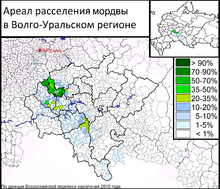
Latham (1854) quoted a total population of 480,000.[4] Mastyugina (1996) quotes 1.15 million.[36] The 2002 Russian census reports 0.84 million.
According to estimates by Tartu University made in the late 1970s, less than one third of Mordvins lived in the autonomous republic of Mordovia, in the basin of the Volga River.
Others are scattered (2002) over the Russian oblasts of Samara (116,475), Penza (86,370), Orenburg (68,880) and Nizhni Novgorod (36,705), Ulyanovsk (61,100), Saratov (23,380), Moscow (22,850), Tatarstan (28,860), Chuvashia (18,686), Bashkortostan (31,932), Siberia (65,650), Russian Far East (29,265).
Populations in parts of the former Soviet Union not now part of Russia are: Kyrgyz Republic 5,390, Turkmenistan 3,490, Uzbekistan 14,175, Kazakhstan, (34,370), Azerbaijan (1,150), Estonia (985), Armenia (920).
List of notable Mordvins
- Erzyans
- Avvakum Petrov, the leader of Old Believers, inside Russian Orthodox Church, burned alive in Pustozersk.
- Alyona Erzymasskaya 17th-century Erzyan female military leader, the heroine of civil war.
- Stepan Erzya (Stepan Nefedov, 1876–1959), sculptor
- Fyodor Vidyayev, World War II submarine commander and war hero
- Aleksandr Sharonov, philologist, poet, writer
- Kuzma Alekseyev
- Vasily Chapayev (Erzya father)
- Mokshans
- Mikhail Devyatayev (1917–2002)
See also
References and notes
- Official site of the Russian Census of 2010. Information materials about the final results of the Russian Census of 2010. (in Russian)
- Molokans and Jumpers are Russians, Ukrainians, Chuvashs, Mordvins, Armenians ...
- "Mordvin". Encyclopædia Britannica. 1967.
- Latham, Robert Gordon (1854). The Native Races of the Russian Empire. H. Bailliere. p. 91.
- Balzer, Marjorie; Nikolai Mokshin (1995). Culture Incarnate: Native Anthropology from Russia. M.E. Sharpe. ISBN 978-1-56324-535-0.
- Janse, Mark; Tol, Sijmen, eds. (2003). Language Death and Language Maintenance: Theoretical, Practical and Descriptive Approaches. John Benjamins Publishing. p. 115. ISBN 90-272-4752-8.
- Feoktistov A. P. K probleme mordovsko-tyurkskikh yazykovykh kontaktov // Etnogenez mordovskogo naroda. – Saransk, 1965. – pp. 331–343
- Isabelle T. Keindler (1 January 1985). "A doomed Soviet nationality ?". Cahiers du monde russe et sovietique. Vol. 26 N1. Janvier–Mars. EHESS. Retrieved 22 October 2010.
- (Getica XIII, 116) "Among the tribes he [Ermanarich] conquered were the Golthescytha, Thiudos, Inaunxis, Vasinabroncae, Merens, Mordens, Imniscaris, Rogas, Tadzans, Athaul, Navego, Bubegenae and Coldae" — The Origin and Deeds of the Goths (116).
- Klima, László (1996). The Linguistic Affinity of the Volgaic Finno-Ugrians and Their Ethnogenesis (PDF). Societas Historiae Fenno-Ugricae. ISBN 978-951-97040-1-2.
- (Kirjanov 1971, 148–149) Laslo
- Kappeler (1982) Taagepera
- Bryant, Edwin; Laurie L. Patton (2005). The Indo-Aryan Controversy. PA201: Routledge. ISBN 978-0-7007-1463-6.CS1 maint: location (link)
- (Sbornik... 1941, 96) see László
- (Safargaliev 1964, 12) László
- (Mokshin 1977, 47) László
- (Mokshin 1977, 47)László
- Bromley, Julian (1982). Present-day Ethnic Processes in the USSR. Progress Publishers.
- "MORDVINS (Erzyas and Mokshas)". Information Center of Finno-Ugric Peoples. Retrieved 14 October 2008.
- Mokshin (1995), p. 43. Latham in his account of the "Native Races of the Russian Empire" (1854) divided the Mordvins into three groups, viz. the Ersad, on the Oka River, the Mokshad, on the Sura River and the Karatai, in the neighbourhood of Kazan.
- "the ethnic structure of the Mordva people at present reveals two subethnoses – Erzia and Moksha – and two ethnographic groups – so-called Shoksha and Karatai" Mokshin (1995), p. 43
- Tengushev Mordvins, Karatai Mordvins, Teryukhan Mordvins, Meshcheryaks, Mishars in Stuart, James (1994). An Ethnohistorical Dictionary of the Russian and Soviet Empires. Greenwood Publishing Group. pp. A491, 492, 545. ISBN 978-0-313-27497-8.
- Eliot, Charles Norton Edgcumbe (1911). . In Chisholm, Hugh (ed.). Encyclopædia Britannica. 18 (11th ed.). Cambridge University Press. pp. 820–821.
- Bryce, James (2005) [1877]. Transcaucasia and Ararat: being notes of a vacation tour in the autumn of 1876. London: Macmillan and Co. → Adamant Media Corporation. p. 172. ISBN 1-4021-6823-3.
- Deviatkina, Tatiana (2001). "Some Aspects of Mordvin Mythology" (PDF). Folk Belief and Media Group of ELM. Retrieved 13 October 2008.
- Mokshin, p. 32
- Pre-and Proto-historic Finns by Abercromby, pp. 8
- Taylor, Isaac (1898). Names and Their Histories. Rivingtons. pp. 289Volga the Rha of Ptolemy, a Finnic name retained by the Mordvins.
- Taagepera, p. 152
- Mokshin (1995), p. 33.
- Tatiana Mastyugina, Lev Perepelkin, Vitaliĭ Vyacheslavovich Naumkin, Irina Zviagelskaia, An Ethnic History of Russia: Pre-revolutionary Times to the Present, Greenwood Publishing Group (1996), ISBN 0-313-29315-5, p. 133; Timur Muzaev, Ėtnicheskiĭ separatizm v Rossii (1999), p. 166ff.
- Властей Мордовии призвали не вмешиваться в деятельность Совета старейшин эрзянского народа https://www.idelreal.org/a/30062876.html
- Erzya approved structure of their national representative bodies http://idel-ural.org/en/archives/erzya-approved-structure-of-their-national-representative-bodies/
- Minahan, James (2000). "Mordvin+language" One Europe, Many Nations. Greenwood Publishing Group. p. A489. ISBN 978-0-313-30984-7.
- Wixman, Ronald (1984). The Peoples of the USSR. M.E. Sharpe. p. A137. ISBN 978-0-87332-506-6.
- Mastyugina, Tatiana; Lev Perepelkin (1996). An Ethnic History of Russia. Greenwood Publishing Group. pp. A133. ISBN 978-0-313-29315-3.
Further reading
- Abercromby, John (1898). Pre- and Proto-historic Finns. D. Nutt.
- Devyatkina, Tatiana. Mythology of Mordvins: Encyclopaedia. Saransk, 2007. (Russian: Девяткина Т. П. Мифология мордвы: энциклопедия. - Изд. 3-е, испр. и доп. - Саранск: Красный Октябрь, 2007. - 332 с.)
- Minahan, James (2000). One Europe, Many Nations: A Historical Dictionary of European National Groups. pp. 489–492. ISBN 978-0-313-30984-7.
- Mokshin, Nikolai F. "The Mordva – Ethnonym or Ethnopholism", chapter 5 of Marjorie Mandelstam Balzer (ed.),Culture Incarnate: Native Anthropology from Russia, M.E. Sharpe (1995), ISBN 978-1-56324-535-0, 29–45 (English translation of a 1991 Sovetskaia etnografiia article).
- Petrukhin, Vladimir. Mordvins Mythology // Myths of Finno-Ugric Peoples. Moscow, 2005. p. 292 - 335. (Russian: Петрухин В. Я. Мордовская мифология // Мифы финно-угров. М., 2005. С. 292 - 335.)
- Sinor, Denis (1990). The Cambridge History of Early Inner Asia. Cambridge University Press. p. 251. ISBN 978-0-521-24304-9.
- Taagepera, Rein (1999). The Finno-Ugric Republics and the Russian State. Routledge. pp. 147–196. ISBN 978-0-415-91977-7.
External links
- "MORDVINS (Erzyas and Mokshas)". Information Center of Finno-Ugric Peoples. Retrieved 14 October 2008.
- Kemal, Mariz. "Erza We Are!". Information Center of Finno-Ugric Peoples. Retrieved 13 October 2008.
- Deviatkina, Tatiana (2001). "Some Aspects of Mordvin Mythology" (PDF). Folk Belief and Media Group of ELM. Retrieved 13 October 2008.
- Library of Congress: A Country Study: Soviet Union (Former)
- The Finns of the steppe and their Mordvin names Article about Mordvin culture and names.
Mordovia news
- Info-RM (in English)
- Info-RM (In the Moksha language)
- Info-RM (In the Erzya language)
Mordvin toponymy (in Mordovia and throughout the Middle Volga region):
- Sándor Maticsák, Nina Kazaeva. "History of the Research of Mordvinian Place Names" (Onomastica Uralica)
- Info-RM republic of Mordovia news in the Moksha language
- Finno-Ugric World news, articles in Moksha
- Moksha-English-Moksha online dictionary
